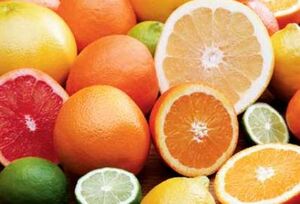Cítricos Valencianos

Cítricos Valencianos are Spanish IGP citrus fruits.
Description
Fruits from the orange (Citrus sinensis, L.), mandarin (Citrus reticultata Blanco) and lemon (Citrus limon L.) trees.
The citrus fruits protected by the IGP ‘Cítricos Valencianos’ will be the following:
— oranges of the navel and blanca groups
— mandarins of the satsuma, clementine and hybrid groups
— lemons
The development and maturity of the fruit must be such as to enable them to withstand transport, storage, preparation and packaging and to arrive at their destination in a satisfactory condition.
IGP protected citrus fruits will be classed as ‘Extra’ or ‘I’ categories, according to the quality standard in force.
Fruit will be sold in containers for food use that have been authorised by the Regulatory Body and consist of 2.5-20 kg boxes and 1-4 kg netting or bags.
Geographical area
The production area for the citrus fruits protected by the IGP designation ‘Cítricos Valencianos’ is formed by a coastal strip stretching North to South and inland to the river valleys, extending to municipalities in the provinces of Castellón, Valencia and Alicante.
Proof of origin
Only citrus fruit grown on plots of land entered in the planting register and handled by storage and packing installations also entered in the appropriate register will be considered as protected by the IGP designation. The Regulatory Body of the IGP will hold registers of: (a) plantations; (b) preparation and packing stores and installations.
The following stages take place inside the installation: reception, transferral to processing line, packaging and dispatch.
The quality of the final product is checked at the packing installations by the inspection service of the Regulatory Body. Documentary checks are also made through comparing producers' compulsory declarations with those at the preparation and packing installations.
Method of production
In the Community of Valencia, citrus fruits have traditionally been grown intensively on irrigated land from small-sized trees that require specialised care and intensive skilled labour. The technical expertise of Valencian growers, a sound knowledge of the crop and soil characteristics result in optimal tree growth and fruit development. The rootstock is taken from species of citrus fruit and their hybrids that are resistant to salinity, lime and the main diseases.
The packing must provide the product with sufficient protection and each package or batch for bulk dispatch must display uniform development and maturity, depending on the place of destination.
At the time of dispatch, the protected citrus fruits will display features characteristic of the variety and comply with the requirements of the legislation in force.
Link
Of all the citrus-growing areas in the world, the tradition is most deeply-rooted in the Community of Valencia. Ancient historical references point to the existence of citrus fruit-growing in the Valencia region. In the Regiment de la Cosa Pública, Francesc Eiximenis (1340-1409) refers to groves of lemon and orange trees in writings describing the beauty of Valencia. In his work Viaje por España y Portugal (1494), Muntzer comments on Valencia's reputation for being ‘abundant in orange, lemon, citron and countless other fruit trees’, adding ‘they are taking us to see the city's huerta, which is densely planted with lemon, orange, lime and palm trees’. Laguna, in his translation of Dioscórides ‘Tratado de Medicina’ (1570), offers evidence relating to oranges and lemons and remarks that ‘Valencians call an orange a grapefruit’. At the end of the 18th century, the botanist Cabanilles mentioned the yield of 4 000 tahullas (old unit of measurement — approximately 1 118 m2) of orange trees from China that produce more than any other crop.
The first commercial plantations for the fresh market date from the end of the 18th century and have steadily expanded to reach a present day total of some 94 000 ha of orange trees, 65 000 ha of mandarin trees and some 15 000 ha of lemon trees. This has enabled a specific culture and techniques to develop, based on the optimum adaptation of this crop to the agroclimactic surroundings and a high quality end product. The existence of the ‘Museo de la Naranja’ in Burriana (Castellón) testifies to the importance of orange-growing for the Community of Valencia.
The growing region consists of alluvial soil from the river basins that stretch from the coast to the mountain ranges and irrigate the Mediterranean coastal plains.
Citrus fruits have adapted perfectly to the Mediterranean climate, with its hot summers and mild winters. The crop is concentrated in coastal areas and valleys, the main limitation being the risk of frost. Rainfall decreases with latitude through the Community of Valencia, ranging from some 450 mm in the North of Castellón to less than 300 mm in southern Alicante. This low rainfall, together with irregular distribution, creates the need for irrigation in the production areas.
Reference: The European Commission'
Find recipes that contain 'Cítricos Valencianos'
#orange #fruit #catricosvalencianos #igp #fruits #lemon #mandarins #lemons #oranges #clementine #lime